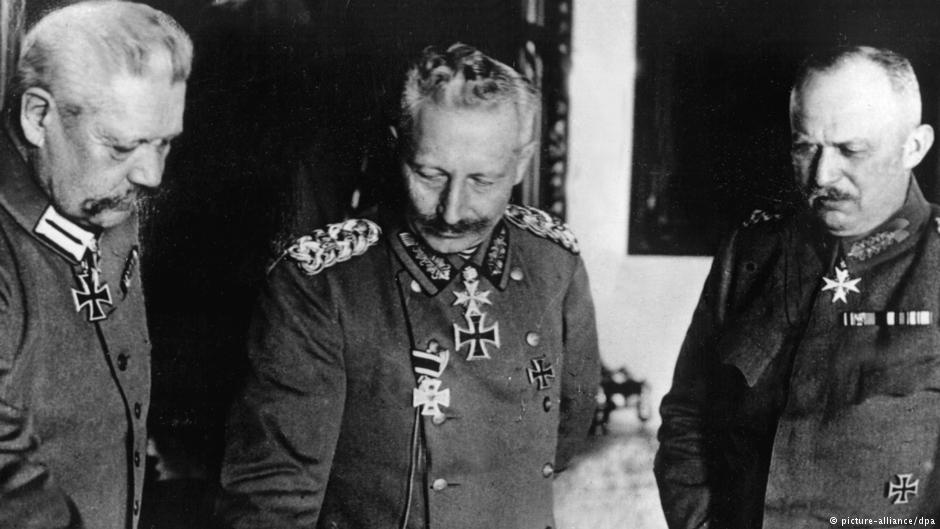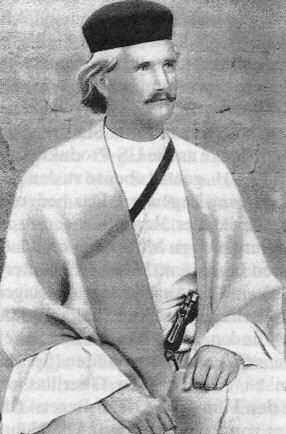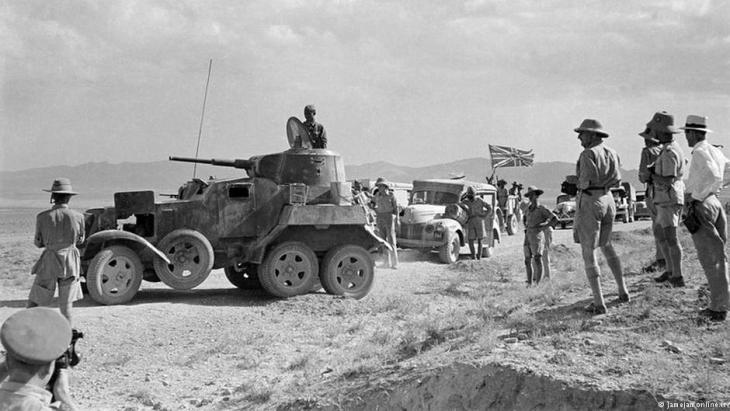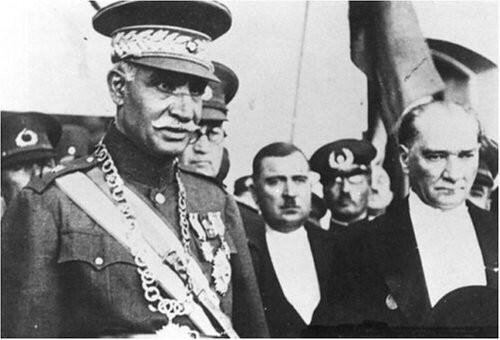How the Germans came to Iran

Maybe one should go to Ohlendorf. For it is possible that this small place in Lower Saxony will bring us closer to solving the mystery of what constitutes the "enigmatic love relationship between Germany and Iran," which "survives every war, every upheaval, every revolution," as Josef Joffe, editor of Die Zeit, has described it.
It is an ambivalent love affair: for some a dangerous liaison between Fascism and Islam, for others a relationship that is as complicated as it is lasting, one that goes far beyond the official and the profanity of politics. What connects the Germans and the Iranians, Germany and Iran? People have been searching for an explanation for a century.
The entire main street of Ohlendorf, once an independent community, today a district of Salzgitter, is named after a son of the town who embodies this "mysterious love affair" like no other German. Wilhelm Waßmuß is the name of the man who was born in 1880 into an impoverished farming family here in the Vorharz, studied Oriental Studies and arrived in Bushehr on the Persian Gulf in 1914 as a German consul. To this day, the municipal archives preserve the estate of this now largely forgotten citizen of the community – whose role was once compared to that of Lawrence of Arabia.
Waßmuß was 34 years old when he came to Iran, yet he had already spent years travelling through various countries in the region. His arrival in Iran marked Germany's active entry into Iranian politics.
The British called the agile diplomat a "German Lawrence". For there are numerous parallels between the activities of the real "Lawrence of Arabia" and those of Waßmuß. Nevertheless, this comparison was and is fatal. For it led to a misunderstanding that still shapes the historical perception of Germans today.

If T.E. Lawrence fought in the service of the British on behalf of the Arab Muslims, who wanted to establish a "true Arab caliphate" and to eliminate the "false caliphate" of the Ottomans, "our Lawrence" must have done something similar, this misunderstanding reads: Wilhelm Waßmuß must also have fought on the southern Iranian battlefields with Iranian Islamists for another caliphate, probably a Persian one. That is how this story has been written and read – right up to the present day.
The Caliphate's economy
And in our days, when Orient and Islamism are often equated and Islamist terror dominates the agenda, a dazzling figure like Waßmuß easily disappears behind such an interpretation of history. Suddenly the First World War – at least the part that took place on Iranian territory – mutates into a holy war in which Islamists were at work. And Wilhelm Waßmuß becomes a German jihadist.
After all, the cliche that the German Empire tried to incite Muslims in the Near and Middle East to a holy war against Russia, France and Great Britain has accompanied us throughout 2018 – whenever anyone has felt it necessary to remind us of the battlefields of a hundred years ago. Cliches are long-lived, they are difficult to stamp out – and these days, more than ever, the concept of Caliphate is booming.
To commemorate the end of the First World War, the weekly newspaper Die Zeit published a long article entitled "The German Jihad". It begins as follows: "100 years ago the Caliphate and the Holy War were already being projected onto power fantasies of a continental scale. But at that time it wasn't fanatical Muslims who dreamed of a theocracy, but German intellectuals and politicians who wanted to harness Islam for their own purposes. They did not even have to wish for a caliphate: it already existed in the form of the Ottoman Empire, which aspired with this title to be the "protective power of Islam".
Anything but Islamism
Where this kind of historiography comes from is another subject on which a lengthy tome could be written. Of course, history can be simplified in this way. But in the case of Iran, it by no means reflects reality. Viewed from the perspective of an Iranian historian, one realises that there is another story waiting to be told. The role played by the Germans on the Iranian stage was new and different.
When Waßmuß arrives in Iran, British troops have already invaded the neutral country. Britain and Russia are in the process of wiping Iran off the world map and integrating it into their world empires. Yet resistance is rife throughout the country. Especially in the south, where Waßmuß does his diplomatic service, the British occupying forces meet with a surprising degree of opposition.
However, neither Islamists are at work nor is anyone looking to establish a caliphate. Iran has just undergone a constitutional revolution restricting not only the power of the monarch but also that of the clergy. In the south of Iran, this revolution has mainly been driven by the tribal leaders of the Qashqai. By extension, they then go on to fight against the British occupiers. Wilhelm Waßmuß joins them. By this time, it is more than 500 years since Iran got rid of the Arab Caliphate.What Waßmuß found in Iran, and what he actively participated in with his own ideas, was an anti-colonial uprising that opposed an imperial power. Of course Wilhelm Waßmuß was also the envoy of a European empire and as such the unconditional representative of German interests. But his Iranian fellow combatants did not see him as the agent of a world empire. To them, empire was above all the preserve of the British and the Russians. It wasn't German troops of occupation that were marauding in the towns and villages of Iran, but British and Russian troops who had already divided the land among themselves.
Waßmuß cannot therefore be used to declare the then Iranian uprising against the British colonial power as an Islamist rebellion aimed at establishing a caliphate. Nor is it appropriate for German authors who think in "nationalist" terms to attempt to instrumentalise him to serve their own interpretation of history. On 23 December 1918, Waßmuß wrote in his diary: "Yesterday evening I pondered what the outcome of the war would be. The death of racial prejudice, I hope".
Cat and mouse with the Brits
Waßmuß was active in southern Iran for four years. His flexibility, bravery and trickery are remembered in countless stories and rumours that are still told today. It is almost impossible to tell truth from legend.

Ultimately, the revolt against the British in southern Iran failed and Waßmuß fell into British captivity. The unrest continued. The British, however, were unable to connect their Indian colony via the south of Iran with Arabia, where Lawrence was at work. Seen in this light, the young German did at least achieve a degree of success, despite the fact that Germany lost the First World War in Europe.
Years later, Waßmuß was released from British captivity. In the years that followed, he fought in vain with German authorities for the release of funds that he had promised to the Persian soldiers for their participation in the resistance against the British. In 1924 he returned to Bushehr, where he bought a piece of land and founded a farm, intending to use its proceeds to pay the wages he had promised the recruits. But even this failed and Waßmuß returned to Berlin a broken man in April 1931, where he died six months later.
Nothing could have been further from the mind of Waßmuß and all the other German intellectuals who engaged with Iran or visited the country 100 years ago than the foundation of a caliphate. Yet from this time onwards, Germany began to develop its presence in Persia – in a completely different way from all other European powers: subtly, sustainably, and probably for that very reason, permanently.
Iran has never regarded Germany as a colonial power: nevertheless, or perhaps precisely because of this, Germany has had more of a cultural and economic impact on Iran than any other foreign country. In order to understand why Germany enjoyed greater success in Iran than all its European rivals, it is necessary to remember the state Iran was in a hundred years ago.
A country disintegrates
The First World War had plunged Iran into a catastrophe. The central state had failed, millions of people starved to death. The country was plagued by unrest. Moreover, Great Britain had occupied the south and was attempting to seize the oil wells there. Iran was disappearing from the map. The British imperial power and Tsarist Russia were the main perpetrators of this catastrophe, or at least that was how the Iranian elite saw it. Anti-British and anti-Russian sentiment prevailed throughout the country. And that was the invaluable capital on which the Germans built their policy in Iran.Wilhelm Waßmuß had been playing a cat-and-mouse game with the British occupying forces in southern Iran for two years when a group of exiled Iranians arrived at the Foreign Office in Berlin. Friedrich Rosen, the best known Orientalist of the time and an expert on Iranian literature, had selected and brought these Iranians together. They were to publish a sophisticated literary anti-British militant magazine. Rosen, Emperor Wilhelm II's foremost diplomat, is said to have suggested the name "Kaveh". Kaveh is a figure from Iranian mythology, a blacksmith who fights and triumphs over tyranny.
"Kaveh" became a highly influential publication that would change Iranian history forever. For six years, from 1916 to 1922, the German Foreign Ministry financed, organised and distributed this unique militant journal. It was to be the best political and literary journal ever published in Persian.
The editorial members were the best known and most capable intellectuals Iran could muster at the time. The editor-in-chief was Hassan Taqizadeh, one of the most dazzling figures in recent Iranian history. He later became a member of parliament, minister, diplomat and ambassador, but also a renowned scientist, publicist and university professor. And Taqizadeh gathered men around him in his Berlin editorial office, all of whom would go on to have a lasting influence on Iranian politics and the intellectual world: for example Mohammad Ali Djamalzadeh, the father of the modern Iranian novel, or Mohammad Ghazvini, founder of modern literary research at the subsequently founded Tehran University.

The triumphant march of Reza Khan
"Kaveh" reflected a patriotic mood that was soon to have a lasting impact. As the fifth annual edition of the magazine was being celebrated in Berlin, an officer of the Iranian Caucasian brigade marched into Tehran with his troops and challenged the declining monarchy. His name was Reza Khan; after his invasion he first became defence minister, then prime minister and three years later the new King of Iran, Reza Shah Pahlavi. The Berlin editors around Taqizadeh had achieved their political goal. Almost all members of the editorial staff returned to Iran at that time.
The magazineʹs former editor-in-chief became Reza Khan's most important advisor. The other members of the editorial staff also supported the new ruler, whose role model Kemal Ataturk was in the process of transforming neighbouring Turkey from the ground up.
Reza Shah also vigorously pushed ahead with the modernisation of Iran. He restricted the power of the clergy and tried to remain neutral in foreign policy. Historians agree that Reza Shah's reforms completed the nation-building project in modern Iran. He is said to have been something of a Germanophile, but it is doubtful whether he even knew the term. Reza Shah was illiterate and only learned to read and write in adulthood.
There is no doubt, however, that during his reign, Germans played a leading role in all the projects with which Reza Shah wanted to transform the country. When it came to founding the university, rebuilding the administration, building roads and providing health care: Reza Shah preferred to rely on Germans.
The heyday of the Germans in Iran
The Trans-Iranian railway project, which was built between 1927 and 1938 and connected Tehran with the Persian Gulf in the south and the Caspian Sea in the north, is legendary. For the construction of this long railway line, German companies founded a consortium in which almost the entire German industry was represented: from Julius Berger, Philipp Holzmann and Siemens to – of course – German banks.
Reza Shah was a patriot. Like Ataturk in Turkey, he wanted to turn Iran into a republic, but the Ayatollahs were vehemently against it. They feared for their power and believed that a republic would inevitably lead to secularism. "The king is the shadow of God" was a dearly held religious tenet.
Yet even as king, Reza Shah forged ahead with his project of secularism, banning women from wearing veils, introducing military service for all Iranians including the mullahs, not to mention secular jurisdiction. In a strange twist of fate, "republic" was Ayatollah Ruhollah Khomeini's main slogan during the revolution that put an end to the monarchy in Iran in 1979.
In terms of foreign policy, Reza Shah tried to manoeuvre between the major powers. It was this neutrality, however, that would prove his downfall. He also wanted to remain neutral during the Second World War. In vain. In March 1941, British and Soviet troops marched into Iran, divided the country once again among themselves and issued an ultimatum to the Shah on 17 September 1941 to leave the country by 12 noon. This he did, embarking on his last journey into exile in South Africa.The reign of Reza Shah was the era of German presence in Iran. Waßmuß's intentions in the south of Iran and the desires of the exiled Iranian intellectuals working in the Berlin Kaveh editorial office would be honoured by the Weimar Republic, the Nazis, and the Federal Republic of Germany.
More than cars and trains
In contrast to other great powers, the Germans did not arrive in Iran with army units. Nevertheless, they arguably contributed more than others – for better or for worse: railways and cars, but also the Fascist bacillus, Communist ideas and even freemasonry.

This aspect of Iranian-German relations was still to be felt on German streets in the latter half of the twentieth century: on 2 June 1967, for example, when Iranian and German leftists protested together in Berlin against Shah Mohammed Reza Pahlavi, son of the Shah who had once been driven into exile. The German student Benno Ohnesorg was shot and the 1968 movement took a new turn. The concept of what is Left, the sayings of Karl Marx and why one should fight for Communism were all imported by the Iranians from Germany.
Taghi Arani, forefather of Iranian Communism and founder of the Communist Tudeh Party, studied chemistry in Berlin. By the time he presented his doctoral thesis on pyrophosphoric acid to his Berlin professors in 1928, Arani had learnt a lot more besides from the Weimar Republic. It was he who, after his return to Iran, translated Marxist books into Persian and founded a cadre party based on the German model. The majority of the party's central committee had also attended German universities. And when the party was banned in Iran, the party leadership fled – to Leipzig.
The macabre side of love
But there is another macabre, even murderous side to this relationship. David Ali S., the German–Iranian and confirmed right-wing extremist who shot nine people in Munich on 22 July 2016, epitomises this eerie interpretation of the relationship that unites many Germans and Iranians. S. considered himself to be an Aryan and felt bullied if his surroundings didn't want to see him like that.
After all, the Nazis in Iran were not only very active propagandists, but in some cases also very successful. Until recently, a swastika hung over the entrance to Tehran's main railway station, and a well-known district of the Iranian capital bears the name "Nazi-Abad" – in other words: urbanised by the Nazis.
In the thirties and forties of the last century there were well-known and influential Iranians who worked for the NSDAP both in Germany and in Iran. The majority of them were not paid agents, but perpetrators by conviction who, after the Second World War, forged careers in Iran similar to those they had pursued in Germany. They were and still are of the opinion that Iran is the country of origin of the Aryans. The overthrown Shah officially called himself "آریا مهر", "the sun of the Aryans".
One of the more bizarre aspects of the German–Iranian relationship is probably freemasonry, which today brings together many an exiled Iranian from Los Angeles to Paris. It is also a phenomenon that the Iranians owe to the graduates of German universities. It was Jafar Sharif-Emami, who studied railway engineering in Germany and later became Iranian Minister and Senate President, who brought this new idea to Iran. In 1969, the influential politician founded a grand lodge in Tehran, to which 43 lodges belonged and which was very active until the fall of the monarchy.
Last but not least there is love: the thousands of bi-national marriages between Germans and Iranians over the last hundred years have certainly helped to keep the relationship between the two countries alive.
Ali Sadrzadeh
© Iran Journal 2018
This article is part of a project of the association "Transparency for Iran e.V.", supported by the German Federal Agency for Civic Education.
